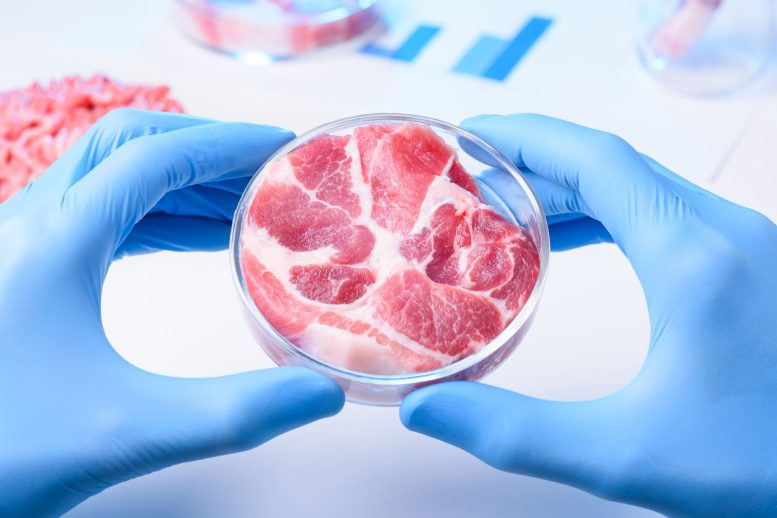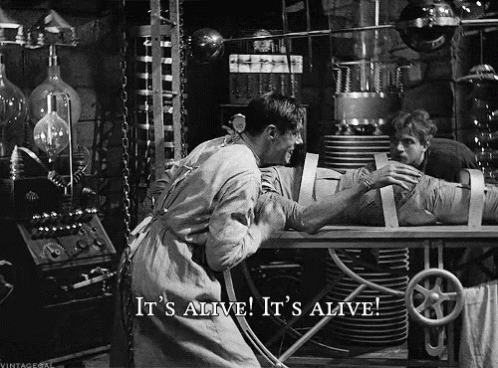
Posted on 08/24/2024 6:25:23 AM PDT by Red Badger

A new study introduces a continuous manufacturing method for cultivated meat that significantly lowers costs and enhances scalability, making it a viable and sustainable alternative to conventional meat and promising major advancements in global food security and sustainability.
===================================================================
A new study showcases a scalable, cost-effective method for producing cultivated meat, marking a significant step towards sustainable and ethical food production.
A pioneering study unveils the first affordable method for producing cultivated meat. The research highlights that continuous manufacturing effectively overcomes the main challenges of scalability and cost, bringing cultivated meat closer to everyday consumers and paving the way for a more sustainable and ethical food system.
In an extraordinary stride for cellular agriculture, Professor Yaakov Nahmias, founder of Believer Meats, and a multidisciplinary team at the Hebrew University of Jerusalem and the cultivated meat industry unveiled a pioneering continuous manufacturing process for cultivated meat. This innovation tackles the industry’s critical challenges of scalability and cost-effectiveness.
The study, published in Nature Food, demonstrates the use of tangential flow filtration (TFF) for the continuous manufacturing of cultivated meat. The new bioreactor assembly permits biomass expansion to 130 billion cells per liter, achieving yields of 43% weight per volume. The process was carried out continuously over 20 days, enabling daily biomass harvests. Additionally, the research introduces an animal component-free culture medium, priced at just $0.63 per liter, which supports the long-term, high-density culture of chicken cells. In other words, this continuous manufacturing method could significantly reduce the cost and complexity of cultivated meat production, potentially bringing it closer to everyday consumers.
Economic Impact and Sustainability
“We were inspired by how Ford’s automated assembly line revolutionized the car industry 110 years ago,” stated Prof. Nahmias. “Our findings show that continuous manufacturing enables cultivated meat production at a fraction of current costs, without resorting to genetic modification or mega-factories. This technology brings us closer to making cultivated meat a viable and sustainable alternative to traditional animal farming.”
Bruce Friedrich, President of The Good Food Institute, expressed his support, stating, “GFI applauds the spirit of openness that continues to characterize cultivated meat researchers like Dr. Koby Nahmias and his colleagues, who understand that showing the scientific potential of cultivated meat will benefit all scientists working in the field.”
This research represents a significant advance in the economic feasibility of cultivated meat, addressing previous concerns about high costs and low yields. Utilizing this empirical data, the team conducted a techno-economic analysis of a hypothetical 50,000-liter production facility. The analysis indicates that the cost of production of cultivated chicken could theoretically be reduced to $6.20 per pound, aligning with the price of organic chicken.
Real-World Data and Cost Reduction
Dr. Elliot Swartz, Principal Scientist at Cultivated Meat, The Good Food Institute emphasized the significance of the study’s findings, stating “This important study provides numerous data points that demonstrate the economic feasibility of cultivated meat. The study confirms early theoretical calculations that serum-free media can be produced at costs well below $1/L without forfeiting productivity, which is a key factor for cultivated meat achieving cost-competitiveness.”
Dr. Swartz added that “Empirical data is the bedrock for any cost model of scaled cultivated meat production, and this study is the first to provide real-world empirical evidence for key factors that influence the cost of production, such as media cost, metabolic efficiency, and achievable yields in a scalable bioprocess design.”
While the authors acknowledged that various other factors would affect the final market price of cultivated meat, this research underscores the potential of continuous manufacturing to significantly lower production costs, making cultivated meat more accessible to consumers and competitive with conventional meat products.
This study not only highlights the promise of cellular agriculture in meeting the global demand for animal products but also aligns with broader environmental and ethical objectives by reducing reliance on traditional livestock farming.
The research represents the first demonstration of cost-efficient manufacturing of cultivated meat and the first empirical economic analysis based on solid data. It is a collaborative effort involving engineers, biologists, and chemists at the Hebrew University of Jerusalem and ADM-funded Believer Meats, which is currently building the world’s first large-scale industrial production facility for cultivated chicken.
Broader Implications and Future Outlook
As global demand for animal protein is expected to double by 2050, cellular agriculture offers a solution to meet this demand, especially as resource-intensive livestock production reaches its peak capacity. Despite recent FDA approvals for cultivated meat production, large-scale production of cultivated meat has yet to become a reality. Previous techno-economic analyses suggested economic challenges, ranging from factory to raw materials costs, casting doubt about the viability of cultivated meat production.
This work presents groundbreaking solutions, including novel filter stack perfusion that reduced factory costs, an animal component-free medium that reduced raw material costs, and continuous manufacturing that increased factory capacity, projecting an annual production of 2.14 million kg of cultivated chicken at cost parity with USDA organic chicken even for a small 50,000-liter facility.
This technological advancement could have a profound impact on animal welfare, food safety, and food security, addressing the needs of a global population increasingly affected by climate change. The study is expected to generate significant interest across multiple disciplines and resonate in popular media due to its implications for the future of humanity.
Reference:
“Empirical economic analysis shows cost-effective continuous manufacturing of cultivated chicken using animal-free medium” by Laura Pasitka, Guy Wissotsky, Muneef Ayyash, Nir Yarza, Gal Rosoff, Revital Kaminker and Yaakov Nahmias, 21 August 2024, Nature Food.
DOI: 10.1038/s43016-024-01022-w
Food Science The Hebrew University of Jerusalem
Making America great again could also make meat prices drop almost in half p4ice wise.
HILLY OR ROCKY LAND WILL NOT work for crops.
THAT IS CALLED “PASTURE”
I read the entire article and I can’t wrap my mind around a cultivated cellular meat product. Toward the end of the article it worked in “climate change.” I suppose to bolster the need for such a soylent green type of protein. I realize that at my age of 62 years I may not be able to appreciate this,but I can’t see something replacing delicious steak/ground beef/pork/sausage/REAL chicken/fish...I believe that God provides all that we need for sustenance with what he created. I would be extremely hesitant to try something like this.
Good. The Left will buy more fake meat, dropping the price of real meat, making it more affordable for normal people...
Fake is fake
Lab scab! My favorite!
If the goal is to create totally brainless Biden chickens that are not conscious and feel no pain, the Demonrats know how. Just put the chickens on multi-generational welfare, give them free Obamaphones with Tik Tok, and make it so the few smart ones can escape the plantation.
As someone else posted long ago, I will eat only things that had a face................

It would certainly allow those who don’t like meat because they are eating their friends an out.
Cultivated Tumor
If they make it in a Lab they can control everything about it which is VERY BAD
As Bobby so emphatically stated yesterday the lab engineers are poisoning us and he wants to stop their insane suicidal march against humanity. Lately I have been trying to get my head around why the government so vehemently and for so long has kept secret from the world the existence of extraterrestrial life. Shockingly, I have come to believe this secrecy may have taken on a whole new dynamic. I believe what we are seeing today in agriculture and health is the result of the government colluding with these entities to attempt to re-engineer God’s creation - humanity. It is evident with Big Pharma’s mind bending, fanatical effort to inject humanity with DNA altering mNRA technology and Big Ag feeding us insects. We need to ask ourselves where does all this crazy social/human re-engineering mindset originate? I believe it could be with entities that are not human. If my assessment is correct it only means that the government now has yet another compelling reason to keep the lid on what they are up to - colluding with god forsaken beings. Is our government willing going along with this re-engineering or are they being forced into doing so? In either case it is diabolic. It is all the more reason why ‘we the people’ need to force the lid off the secrecy and what ‘our government’ is up to with these entities.
and if they have thousands of labs making this crap how much energy will that use ? Well it’s always MORE
AI's response:
Based on the provided search results, cultivated chickens refer to a type of chicken meat produced through cell-cultivation technology, also known as lab-grown or cell-cultivated meat. This alternative to traditionally raised broiler chickens is created by growing animal cells in stainless steel tanks, rather than hatching eggs and raising them on farms.
My response to the whole idea is not only no, but hell no. Our processed food we consume is what is making the American people the sickest humans on earth.
Calley & Casey Means: How Big Pharma Keeps You Sick, and the Dark Truth About Ozempic and the Pill
It's a long video (2 hours & 20 minutes) but extremely informative.
From what I have read is that you can turn just about any land into arable land, if you are willing to do the work and it has access to water.
I’m not saying that you can switch on a dime, just in time.

Uh, it’s not meat.
What if WE are the LAB GROWN MEAT?.......
Disclaimer: Opinions posted on Free Republic are those of the individual posters and do not necessarily represent the opinion of Free Republic or its management. All materials posted herein are protected by copyright law and the exemption for fair use of copyrighted works.